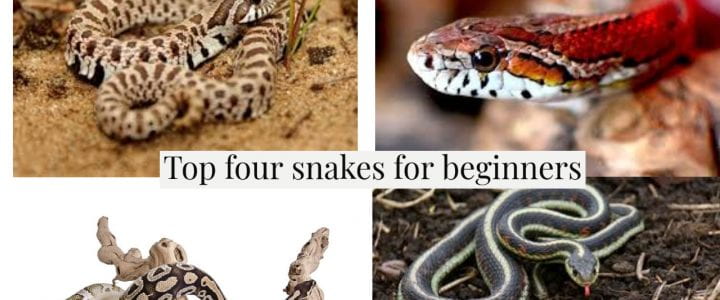All four snakes in this article are non-harmful to humans and are in no particular order.
The Ball Python
The ball python (Python regius) is a medium-sized snake that only grows 5 to 6 feet females can grow larger and are generally larger than the males. There are around 3,500 different morphs or colors and patterns of the ball python. All the different types make for interesting new morphs that you get with breeding different morphs to each other. Herpetoculturists enjoy keeping these snakes for breeding purposes or having them as a pet. With good care, ball pythons thrive in captivity and are great for first-time owners of a snake. With the right care, ball pythons can live to around 30 years so you need to make sure that you can take care of them and are dedicated to them and their well-being. Ball pythons have recurved teeth that hold the prey until the Ball python constricts. Like all snakes, the Ball python swallows its prey whole and does not rip or tear it. Ball pythons are a great starter snake that you can have for many years.
The Easter and Western Hognose
The Eastern Hognose (Heterodon platirhinos) and Western Hognose (Heterodon nasicus) are known to have upturned noses and keeled dorsal scales. Both the Eastern and the Wester hognose only get to the size of about 35 inches and weighing about half a pound. The Eastern Hognose lives in gravely or sandy fields or in pine forests or river valleys to feed off of toads which are their primary food source. They often like to live near water and breeding grounds for the toads. The Western hognose lives in primarily sandy prairies, floodplains, and scrublands. Western Hognose mostly feed off of toads which they find burrowed in the sand. Eastern Hognose live an unknown amount of time in the wild but live around 6 or 7 years in captivity. Western hognose have a longer lifespan of 18 to 30 years.
The Corn Snake
The Corn Snake (Elaphe [Pantheropis] guttata) is a red or orangish-brown color snake and get 24 to 72 inches long. Corn snakes also have a white or cream and black checkered belly. Corn snakes spend a lot of time underground and hiding under rotten trees and bark. In the summer months, corn snakes are active in the day and night but prefer to be out at night. The corn snake is a constrictor and prefers to quickly strangle their prey. Corn snakes eat a variety of reptiles including other snakes, mammals, and birds. Female Corn snakes can lay 10 to 30 eggs in one clutch. Corn snakes are often mistaken for Copperheads although Copperheads have hourglass-shaped spots and are browner and meaner than Corn snakes.
The garter snake
The Garter snake (Thamnophis sirtalis) is a yellow snake with dark green stripes down its back and sides. The garter snake eats mostly bugs, other snakes, and toads. The garter snake is viviparous or gives birth to live young whereas other snakes lay eggs. The Garter snake can have around 50 babies at a time. The garter snake, like most other snakes, swallows their food whole and is non-venomous but uses their slightly toxic saliva that does nothing to humans helps them capture their prey.
For more information on these snakes you can go to these websites:
https://www.reptilesmagazine.com/5-great-beginner-pet-snakes/
Ball pythons:
https://www.reptilesmagazine.com/ball-python-care-sheet
https://www.hoglezoo.org/meet_our_animals/animal_finder/ball_python/
Hognose:
https://srelherp.uga.edu/snakes/hetpla.htm
https://www.wildlife.state.nh.us/wildlife/profiles/hognose-snake.html
https://www.elmwoodparkzoo.org/animal/western-hognose-snake/
Corn snakes:
https://nationalzoo.si.edu/animals/corn-snake
https://srelherp.uga.edu/snakes/elagut.htm
Garter snakes:
https://srelherp.uga.edu/snakes/thasir.htm
https://vtfishandwildlife.com/learn-more/vermont-critters/reptiles/common-garter-snake




